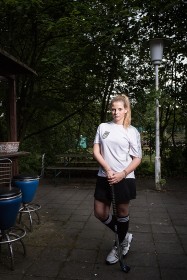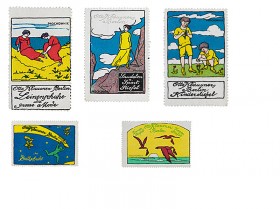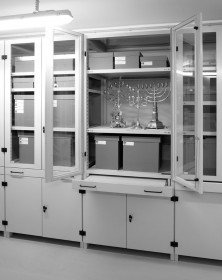The 14th European Maccabi Games (EMG) are taking place in Berlin from 27 July until 5 August 2015. More than 2,000 Jewish athletes from 36 countries will compete in 19 sports from football to fencing to chess. To accompany the games Tamar Lewinsky and Theresia Ziehe are producing a series of portraits with interviews, introducing a new member of the German delegation from Berlin every day here on the blog. They conducted the interviews on the grounds of the TuS Maccabi in Berlin’s Grunewald where Stephan Pramme also shot the portraits.
Sarah Geldmann (25), Hockey

Sarah (25) hockey © Jewish Museum Berlin, photo: Stephan Pramme
Sarah, what meaning does it hold for you that the European Maccabi Games are taking place in Berlin?
The symbolism is intense, I think. We represent Jewish life in Germany, and, as hosts, we can show other nations that there aren’t just a few of us in Germany, as some may think. There is Jewish life here, and Berlin has become a hotspot for Israelis. Even if some had concerns, it’ll for sure be a great event.
Jewish athletes were barred from the 1936 Olympics. Now this is exactly where most of the European Maccabi Games are taking place. What do you think about that?
Of course, it has a huge historical meaning. There are survivors who are with us, and I’m proud we can show them we’re here again. → continue reading

Five stamp-sized advertisements for the company Otto Klausner GmbH, Berlin, ca. 1910-1914. Gift of Peter-Hannes Lehmann
Like every museum, we have some objects in our collection that are always on display for our visitors, some that we show from time to time in temporary exhibitions, and also some that we rarely show because they are more suited to research purposes. And then there are objects that we should have put on view long ago but they are still sitting, out of sight, in our warehouse. It affords a particular pleasure when such items finally get processed for our online database and put on display.
A collection that falls into this category is a set of graphics by Leo Prochownik (1875 – 1936) → continue reading

View of Jewish Musem-Berlin storage,© Jewish Museum Berlin, photo: Jens Ziehe
It’s cold. The neon light casts a harsh glare. A gray cabinet stands next to another along white walls. The room feels sterile. The air conditioning hums. A gloomy place.
I put on blue, latex gloves, open one of the cabinets and take out a gray carton. Contours of an item shimmer from under layers of tissue paper. Carefully, I take the object out of the carton and free it from the paper; a microcosm of history presents itself, as if this gloomy place accentuates the aura of the item, the room itself taking a whole step back. → continue reading


